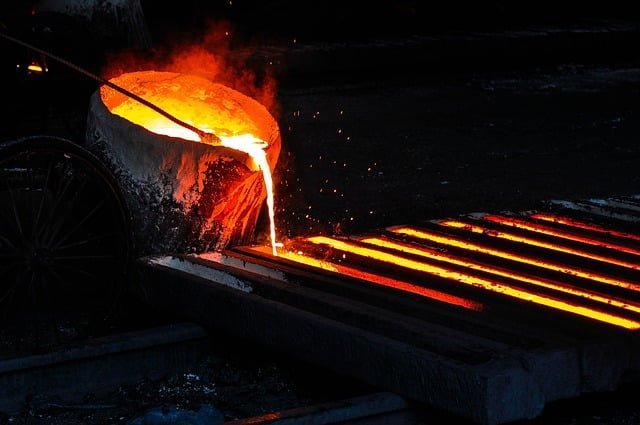Heat Treatment of Large diameter Steel Pipes
Features:
- Inside the furnace the big size pipes, to be heat-treated, are charged likewise on cantilever supported un-cooled rolls. However the rolls are mounted on a straight axis. The shells of the rolls are likewise of high heat resistant alloys. Individual gear motors and universal shafts drive the rolls.
- Once the pipe has been positioned at the centre of the furnace it is picked up by a mechanical transfer system from the stationary charging rolls and placed onto the fixed beam system.
- The moving and fixed beams of both furnaces are equipped with trough-type profiles and are of heat-resistant castings. This design ensures rotation of the pipes with each movement of the walking beam during the transport through the furnace.
- During furnace idling time or between cycle times the pipes are kept rotating at the spot.
- The walking beam frame of the furnace is driven by bell crank levers across tracks connected by tension and transverse rods. All rollers are equipped with anti-friction bearings and are connected to a central lubricating system.
- Hydraulic cylinders are provided for the lifting and lowering. Cylinder synchronisation is achieved through a synchronising shaft.
- After the pipes have been normalised, they are transferred to likewise cantilevers supposed discharge rolls. These rolls, however, are indirectly water cooled. The roll shells are of high heat resistant alloys.
| Charge | Pipes upto 600 mm |
| Grades | Oilfield Tubular Steels / Structural Steels / Microalloyed fine grain steels |
| Pipe Length | Pipes upto 29,000 mm |
| Wall thickness | 5 – 20 mm |
| Hardening Furnace | 1050°C ( max.) |
| Tempering Furnace | 750° C ( max.) |
| Firing | Direct fired |
| Furnace Capacity | upto 75 TPH |
Heat Treatment Plants for Annealing Electric Steel
Exclusively in manufacturing of low voltage asynchronous and hermetic motors
Committed to excellence-Increase performance-Drive Innovation-Act responsively -Value People-Attract and empower talent-Customer focused Non-siliconized or low-siliconized semi-finished strip is increasingly used for the manufacture of magnetic cores for electrical equipment. The cores are fabricated from cold rolled strip which undergoes critical deformation after recrystalization and must be annealed after punching. Following annealing, core loss is of an order of 2 to 4 W/kg for a sheet thickness of 0.5 to 0.7mm. Electrical sheet manufactured by this process is superior to dynamo strip not only with regard to cost but also with regard to:
- saturation
- A.C. premeability
- core loss (due to magnetic transformation)
- ageing
- lamination factor and
- the quality of the cutting edges
Appropriate temperature and furnace atmosphere control induces three simultaneous heat-treatment effects needed to fabricate material of the properties required. The hard, fine-grained ferritic structure is transformed into a soft coarse-grained structure according to ASTM series 2½ to 3½. At the same time, the carbon content of the metal is reduced to less than 0.005% to prevent any effect of residual carbon on the properties of the material ageing. Further, an oxide coating is obtained at a temperature of 550°C. Decarburization and plating necessitate permanent contact between the reaction gas and the strip surface. The oil, normally applied prior to punching the laminations, is burnt off in the first heating zone.
| Coe Loss | Unit | After Punching | After Annealing |
|---|---|---|---|
| P1.0 | W/Kg | 8.0-9.5 | 2.9-3.2 |
| P1.5 | W/Kg | 16.5-18.5 | 5.5-7.5 |
| Flux Density | |||
| B 25 | T | 1.45-1.55 | 1.64-1.68 |
| B 50 | T | 1.68-1.70 | 1.74-1.77 |
| Aging | % | 0-2 | 2-3 |
| Carbon Content | % | 0.060-0.080 | 0.003-0.005 |
| Grain Size | ASTM | 8-10 | 2-3 |
| Oxide Layer Thickness | M | 0 | 0.8-1.6 |
| Burr Height | mm | Max 0.05 | Max 0.04 |
| Vickers Hardness HV 5/30 | Kp/mm2 | 130-160 | 60-80 |
| Tensile Strength | N/mm2 | 380-450 | 250-300 |
| Yield Strength | N/mm2 | 3330-360 | 200-250 |
| Elongation | 0% | 15-25 | 25-35 |
Heat Treatment Of Steel Pipes & Rods
Normalising, Soft Annealing, Bright Annealing with or without controlled Atmosphere Encon Group has the requisite expertise and capabilities in developing the creative, economical solutions of furnaces required for heat treatment of pipes, rods and bars. These furnaces can be either Batch or Continuous Roller hearth types with or without protective atmosphere. The Emerging Energy Efficient Furnace Builder & combustion solutions provider
Furnace Types
- Furnace for Normalizing ( Recrystallising and Stress Relieving)
- Furnace for Spherodising, Soft Annealing
- Furnace for Solution Annealing, Hardening, Quenching & Tempering.
- Furnace for the bright annealing of refrigerator tubes and braking system pipes
Advantages
- High Capacity and easy adaptation of conveyor systems to annealing process
- Gas- tight Furnace suitably designed for protective atmospheres.
- Low Maintenance requirements
- High Furnace availability
- Extremely versatile in application
Configuration
- A charging table for charge preparation,
- A cross conveyor, to transfer the charge to the inlet roller table of the furnace.
- A furnace seal system for effective separation of the furnace atmosphere from the ambient air, the direct-fired or indirect-fired furnace with downstream cooling section.
- A seal system at the cooling section outlet
- An outlet roller table with discharging system
These components can also be installed in a number of other configurations
Features
- Single ended Radiant Tube Burners compared to U-type Burners
- Individual Ignition Control of every burner
- Burner control in On-Off – Round Robin mode versus continuous control.
- State of Art PLC and PC – System for Furnace Control
- Special selected Refractory
- Inlet Table width increases from Inlet Table to Furnace, to Cooling Section to Outlet Table
- Separate Cooling water controls for Cooling section walls, roof and waterbox
- Sufficient Cross Transfer Table and Roller Spacing to always support tubes
- Gear with special transmission ratio allowing even hand movement of furnace roller
- Nitrogen supply at Inlet Outlet to put out possible fire





